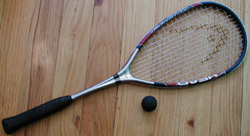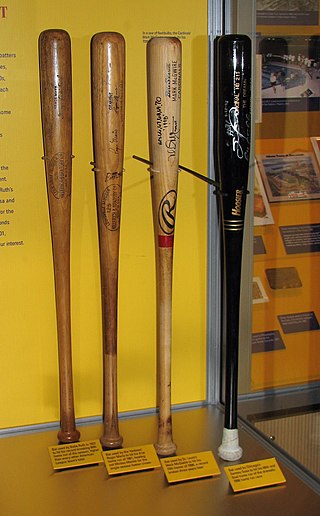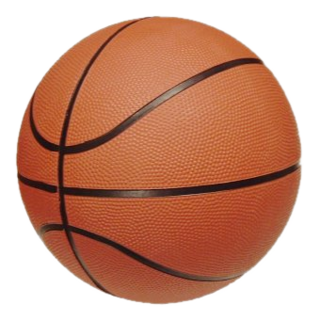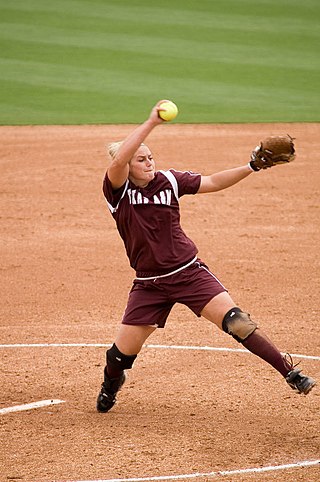Related Research Articles

A racket or racquet is a sporting equipment used to strike a ball or shuttlecock back-and-forth in games such as tennis, badminton, squash, racquetball and padel. The typical basic structure of a racket consists of a widened distal end known as the head, an elongated handle known as the grip, and a reinforced connection between the head and handle known as the throat or heart.

Softball is a popular variation of baseball, the difference being that it is played with a larger ball on a smaller field and with only underhand pitches permitted. Softball is played competitively at club levels, the college level, and the professional level. The game was first created in 1887 in Chicago by George Hancock.
A cricket bat is a specialised piece of equipment used by batters in the sport of cricket to hit the ball, typically consisting of a cane handle attached to a flat-fronted willow-wood blade. It may also be used by a batter who is making batter's ground to avoid a run out, by holding the bat and touching the ground with it. The length of the bat may be no more than 38 inches and the width no more than 4.25 inches. Its use is first mentioned in 1624. Since 1979, a law change has dictated that cricket bats can only be made from wood.

USA Baseball is the national governing body for baseball in the United States, and is a member of the United States Olympic Committee and the World Baseball Softball Confederation. The organization is responsible for the selection of the United States national team for various international competition, including the senior professional team, the collegiate national team, the various youth national teams, and the women's national team.

A baseball bat is a smooth wooden or metal club used in the sport of baseball to hit the ball after it is thrown by the pitcher. By regulation it may be no more than 2.75 inches (7.0 cm) in diameter at the thickest part and no more than 42 inches (1.067 m) in length. Although historically bats approaching 3 pounds (1.4 kg) were swung, today bats of 33 ounces (0.94 kg) are common, topping out at 34 to 36 ounces.

In baseball, batting is the act of facing the opposing pitcher and trying to produce offense for one's team. A batter or hitter is a person whose turn it is to face the pitcher. The three main goals of batters are to become a baserunner, to drive runners home or to advance runners along the bases for others to drive home, but the techniques and strategies they use to do so vary. Hitting uses a motion that is virtually unique to baseball and its fellow bat-and-ball sports, one that is rarely used in other sports. Hitting is unique because it involves rotating in the horizontal plane of movement, unlike most sports movements which occur in the vertical plane.

Homebuilt aircraft, also known as amateur-built aircraft or kit planes, are constructed by persons for whom this is not a professional activity. These aircraft may be constructed from "scratch", from plans, or from assembly kits.

College baseball is baseball that is played by student-athletes at institutions of higher education. In the United States, college baseball is sanctioned mainly by the National Collegiate Athletic Association (NCAA); in Japan, it is governed by the All Japan University Baseball Federation (JUBF).

Collegiate summer baseball leagues are amateur baseball leagues in the United States and Canada featuring players who have attended at least one year of college and have at least one year of athletic eligibility remaining. Generally, they operate from early June to early August. In contrast to college baseball, which allow aluminum or other composite baseball bats, players in these leagues use only wooden bats, hence the common nickname of these leagues as "wood-bat leagues". Collegiate summer leagues allow college baseball players the ability to compete using professional rules and equipment, giving them experience and allowing professional scouts the opportunity to observe players under such conditions.

A lacrosse ball is the solid rubber ball that is used, with a lacrosse stick, to play the sport of lacrosse. It is typically white for men's lacrosse, or yellow for women's lacrosse; but the balls are produced in a wide variety of colours.
The Oracle Certification Program certifies candidates on skills and knowledge related to Oracle products and technologies.

A basketball is a spherical ball used in basketball games. Basketballs usually range in size from very small promotional items that are only a few inches in diameter to extra large balls nearly 2 feet (60 cm) in diameter used in training exercises. For example, a youth basketball could be 27 inches (69 cm) in circumference, while a National Collegiate Athletic Association (NCAA) men's ball would be a maximum of 30 inches (76 cm) and an NCAA women's ball would be a maximum of 29 inches (74 cm). The standard for a basketball in the National Basketball Association (NBA) is 29.5 inches (75 cm) in circumference and for the Women's National Basketball Association (WNBA), a maximum circumference of 28.5 inches (72 cm). High school and junior leagues normally use NCAA, NBA or WNBA sized balls.

Fastpitch softball, or simply fastpitch, is a form of softball played by both women and men. While the teams are most often segregated by sex, coed fast-pitch leagues also exist. Considered the most competitive form of softball, fastpitch is the format played at the Olympic Games. Softball was on the International Olympic Committee (IOC) program in 1996, 2000, 2004, 2008, and 2020. It will not be a part of the 2024 Summer Olympic Games in Paris.

Charles Schwab Field Omaha is a baseball park in Omaha, Nebraska. Opened in 2011, the stadium serves as a replacement for historic Johnny Rosenblatt Stadium.
Composite baseball bats, opposed to aluminum or wood baseball bats, incorporate a reinforced carbon fiber polymer, or composite, into the bat's construction. This composite material can make up all or part of the bat. Bats made entirely of this polymer are referred to as composite bats. Bats which only incorporate a portion of polymer are referred to as composite hybrids.
The 2011 NCAA Division I baseball tournament began on Friday, June 3, 2011 as part of the 2011 NCAA Division I baseball season. The 64 team double elimination tournament concluded with the 2011 College World Series in Omaha, Nebraska, on June 29, 2011.
The National Operating Committee on Standards for Athletic Equipment is a nonprofit standards organization which develops standards for the manufacture of certain protective athletic equipment in the sports of baseball, football, hockey, lacrosse, and polo. NOCSAE conducts and funds scientific research and collects and analyzes data relating to standards development.

Caged IBC totes are one of, if not the most commonly used, of all current intermediate bulk container design types. Caged IBC totes are handling and shipping containers for the storing, transit, and operation integration of various commodities, with the most common being water. Caged IBCs are often utilized as one-use containers, especially when it comes to hazardous materials, but are also suitable for reuse under many conditions. This IBC type often features an interior liner, blow-mold manufactured from polyethylene, that is structurally supported by a protective cage frame, often of galvanized steel composition. Caged IBCs are engineered for the bulk handling of liquids, semi-solids, as well as solid materials. All materials can present certain safety and compatibility concerns, especially hazardous liquids, and proper guidance is always recommended whenever using caged IBC totes for harsh chemicals.
Boning is the practice in American baseball of treating a baseball bat with a bone. The bone is run repeatedly up and down the barrel of the bat. The practice has the benefit of slightly hardening the bat by compressing the surface wood cells, and also of boosting hitting on the grounds that bone and hide go together, thus bone attracts hide, and as the baseball is covered in hide it will be attracted to the boned bat.